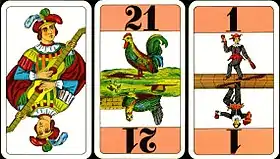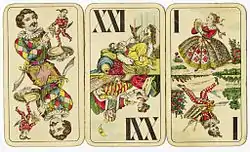Cego
Cego or Baden Tarock (German: Badisches Tarock), also called Ceco (from Latin: caecus, meaning blind), is a tarot card game played mainly in the Upper Rhine valley,[1] the Black Forest, the adjacent Baar lowland[2] and around Lake Constance in Switzerland and Austria. The game is similar to Königrufen and Tapp-Tarock. It is distinguished by a large skat, or talon, called "the Blind".
 The honour trumps in a Cego deck. | |
| Origin | Germany |
|---|---|
| Alternative names | Zeco |
| Type | Trick-taking |
| Players | 3-4 |
| Skills required | Tactics, Strategy |
| Cards | 51 or 54 |
| Deck | Tarock |
| Play | Counter-clockwise |
| Card rank (highest first) | Trumps: Stieß, 21-1 Black suits: K Q C J 10 9 8 7 Red suits: K Q C J 1 2 3 4 |
| Playing time | 30 min. |
| Random chance | Moderate |
| Related games | |
| Tapp-Tarock, Königrufen, Zwanzigerrufen | |
History and development
Cego is seen as part of the cultural heritage of the Black Forest and South Baden region.[3] After the defeat of Further Austria, in 1805 much of its territory was allocated to the Grand Duchy of Baden. During the ensuing Napoleonic Wars, soldiers from Baden deployed with Napoleon's troops to Spain where, among other things, they learnt a new card game, Ombre. They took this back to Baden and adapted it to be played with Tarock playing cards that were then still in popular use in southern Germany.[4] Cego was sufficiently popular to develop into the national game of Baden and Hohenzollern and these are the only regions of Germany where Tarot or Tarock cards are still used for playing games.[5] The game has grown organically and there are many regional variations but in recent years, the establishment of a Cego Black Forest Championship has led to official tournament rules being defined.[4][3] In addition, regular courses and local tournaments are held and it is a permanent feature of Alemannic Week, held annually in the Black Forest at the end of September.[6]
The noted German economist Gerold Blümle has researched, lectured, taught and written on the subject of "Baden's national game of Cego".[7][8]
Deck
Cego traditionally uses a French-suited animal tarot deck called Adler-Cego (Eagle Cego) that dates to the early 19th century, although F.X. Schmid also created a Cego Tarock pack with genre scenes that is still produced. The French-suited Tarot Nouveau deck was also sometimes used, particularly in Alsace. Unlike the Tarot Nouveau which used 78 cards instead of 54, and much like the Industrie und Glück, the Adler-Cego deck consists of 54 cards which include of 22 trumps, 16 face cards (images) and 16 pip cards (empty cards). Trump 1 shows the Kleiner Mann (based on Hanswurst) while trump 2 has mythological hybrids. Trumps 3 to 21 depict real animals. The highest trump lacks the pink panels that the other trumps have on both ends of the cards depicting its rank in Arabic numerals. Instead, it shows a gleeman and is called the Stieß or G'stieß (Fool). Despite the name, eagles do not appear in any of the cards.[9][10]
All other cards (face and pip cards) are of the plain suits: clubs, spades, hearts, and diamonds. In addition to the King, Queen, and Jack there is also the Knight. Face cards cannot win over the trumps, but are important because of their card value with respect to the total of points. Pip cards have neither high card value nor are they very useful in winning tricks. Like the Industrie und Glück deck, the red pip cards are numbered from one to four (one being the highest card) and the black pip cards are numbered from ten to seven, with no corner indices. The last manufacturer of this deck is ASS Altenburger.
When playing with a Tarot Nouveau deck, all blacks suits (Spades and Clubs) from Aces to sixes and all red suits (Hearts and Diamonds) from fives to tens are removed before playing.
Rules
Cego can be played by three or four players. Play proceeds counter-clockwise. Normally, one player plays against the rest. By winning tricks he tries to accumulate more card points than the rest of the players together - just as in Skat, a popular German card game. There are some special games called "Räuber" (robber), "Drescher" (thresher), in which every player plays for himself.[11]
Unlike Skat and other major card games, Cego has no official set of rules. Thus, every region has established their own set of traditional rules. Sometimes, the rules differ even within a village. The following description is therefore to be seen as a general guideline only.
Dealing
4 players: The dealer deals 11 cards per player and 10 cards separately on the table. Those ten cards are called the blind (Der Blinde).
3 players: Every player gets 13 cards, 12 go into the blind.
With three players, the seven of spades, the seven of clubs, and the four of diamonds are taken out of the game; it is played with 51 cards only. In either case, there is no special order of dealing (unlike Skat).
After the dealing
After the dealing the players have to check if they can play a Solo: If a player has more than 8 trumps (truck), or 8 trumps + only 2 colors + 2 trumps with a card value higher than 17 he should call a Solo. If no one goes against it this player will play a hand game. He may not look at the blind but it counts for him during scoring.
The solo can be played as ultimo, if one has strong trump and additionally the small man (trump number 1). At the ultimo the last trick has to be taken with the small man. In some regions ultimos are also played with the 2- or 3-trump or with specific combinations of 1-, 2-, and 3-trumps. Playing solo one can call beforehand that he will not lose any tricks (called Durchmarsch i.e. a "march").
If a player meets the requirements for a solo but doesn't say it, it's possible for the player who takes the blind to demand that all cards are put on the table. If a player is then caught copping-out the Solo, he has to pay the game (8 times the last bidded game value). This process called Schinden is not cheating, but a legal way of conduct bearing the risk of being caught.
If a player wants to play a solo the other players can be against it and can play a Gegensolo. The player on the right hand side from the player who announced a solo has to decide first if a solo is okay or not. If everyone is okay with a solo then the player who announced it is allowed to play it.
The bidding
If nobody wanted to play a Solo the player besides the dealer (to the right) has to announce a Cego. The others are now allowed to bid in this order:
1.Cego
The player has to put 2 cards from his hand (best would be 2 trunks) onto the blind. The other cards on his hand change into points. The 12 cards (4 player) / 14 cards (3 player) are the cards the player has to play with now. One card though has to be put down onto the cards which count as points that everybody has the same number of cards on the hands. The player of the cego is allowed to look at his points in the first three rounds. If the player forgot to put down a card and has one card to much in the end he loses the game.
2. Half (Halbe)
The player has to put one card onto the blind. The player also has to play a pip card face up. Then the blind changes into the cards he has to play with. The others change into points. One card has to be put onto the pile that the cards on his hand are 10. If the player want he can change the pip card into a face card he has on his hand.
3. One Card (Eine)
The player has to put one card onto the blind and has to play with them. The rest of the cards change into points.
4. One Blank (Eine leere)
The player has to play a pip card face up. He has to play with the blind and the other cards turn into points.
5. Two Blanks (Zwei Leere)
The player has to play two blank cards (same colour). One for the first round one for the second round. Then he plays with the blind and his cards from earlier change into points.
6.Two Different (Zwei Verschiedene)
The player has to play 2 pip cards. One for the first round and another one for the second round. Then his cards change into points and he has to continue playing with the blind.
7. Littl' Un (Kleiner Mann / Babber)
This is the last bid. If one of the bidding players has the 'little man' (first trump) he can play a Littl' Un (Kleiner Mann). He has to play the small man in the first round and plays then with the blind. The other cards he had on his hand change into points.
A playing can bid high if he a lot of court cards / points in his hand, since the cards in his hand become points. If a player wants to play a Half (Halbe) the player who announced Cego has to be okay with it before the other players can bid. If he is okay with it, the others can announce One Card (Eine). All the other players have to be okay with it before the player who announced the game is allowed to play it.
Special Games
Special games may also be bid for. They are:
1. Piccolo
It does not matter if anybody wants to play a Half (Halbe) or anything else. Piccolo has priority. The player has to try to win one round. So he is not allowed to win with two cards and not less either.
2. Bettel
Same as Piccolo but this time the player is not allowed to win anything at all with his cards.
3. Räuber
If everyone else passes, the player who announced Cego can announce a Räuber. That means that all players play for themselves. There is only one loser and that's the person who gets most of the points. In the first round the player who has the Gstieß has to play it. Second round the Mund (21) and third Geiß (1).
References
- "Es geht um Cents und Emotionen". Badische Zeitung (in German). 27 October 2015. Retrieved 1 April 2016.
- Cego – ein altes Kartenspiel, das eine Renaissance erlebt at www.schwarzwaldregion-freiburg.de. Retrieved 23 Feb 2019.
- Cego - Regeln at cego.de. Retrieved 17 May 2020.
- Vermutliche Herkunft at cego-online.de. Retrieved 17 May 2020.
- Cego at pagat.com. Retrieved 17 May 2020.
- Cego - ein altes Kartenspiel, das eine Renaissance erlebt at schwarzwaldregion-freiburg.de. Retrieved 17 May 2020.
- "Cego soll wieder salonfähig werden" in Badische Zeitung, 27 Apr 2011. Retrieved 30 May 2020.
- Das badische Nationalspiel Cego at swv-schopfheim.de. Retrieved 30 May 2020.
- Mann, Sylvia (1990). All Cards on the Table. Leinfelden: Jonas Verlag. pp. 67, 83, 315.
- Depaulis, Thierry (1984). Tarot, jeu et magie. Paris: Bibliothèque Nationale. pp. 119–120.
- McLeod, John. Cego at pagat.com. Retrieved 10 December 2016.
External links
- Cego - website dedicated to Cego.
- Cego-online - website dedicated to Cego.
- "Das badische Nationalspiel Cego". Article by Blümle in the Wirtschaftliche Freiheit, 30 July 2018.
- Traditional Adler Cego pack by ASS Altenburger
- Cego pack with genre scenes by F.X. Schmid
- Microscopique Tarock pack by Dondorf of Frankfurt.
